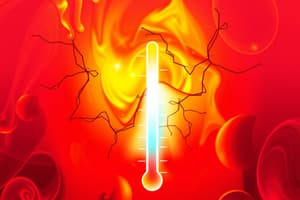Podcast
Questions and Answers
Why can some organisms, especially in a resting stage, exist at very low temperatures?
Why can some organisms, especially in a resting stage, exist at very low temperatures?
- They have special adaptations that allow them to survive at low temperatures. (correct)
- They prefer the extreme cold temperatures for their life processes.
- Their metabolic rate increases at low temperatures.
- They go into a state of hibernation to conserve energy.
How do constant temperatures affect organisms that are normally subjected to variable temperatures in nature?
How do constant temperatures affect organisms that are normally subjected to variable temperatures in nature?
- They are depressed, inhibited, or slowed down. (correct)
- They adapt quickly to constant temperatures.
- They become resistant to temperature changes.
- They are accelerated in growth and reproduction.
What is the ultimate source of energy for life on Earth?
What is the ultimate source of energy for life on Earth?
- Temperature fluctuations
- Oxygen
- Light (correct)
- Water
Why is light considered a limiting factor for organisms?
Why is light considered a limiting factor for organisms?
How does light quality impact organisms?
How does light quality impact organisms?
What is the ecological importance of light intensity and duration?
What is the ecological importance of light intensity and duration?
What is the main reason why sunlight quality does not have a significant impact on the rate of photosynthesis in terrestrial ecosystems?
What is the main reason why sunlight quality does not have a significant impact on the rate of photosynthesis in terrestrial ecosystems?
How does water play a role as a limiting factor in both land and saline water environments?
How does water play a role as a limiting factor in both land and saline water environments?
Which of the following factors is NOT a principal factor measured when considering the impact on organisms?
Which of the following factors is NOT a principal factor measured when considering the impact on organisms?
How does the distribution of rainfall over the year affect organisms?
How does the distribution of rainfall over the year affect organisms?
What is the significance of humidity for organisms in the air?
What is the significance of humidity for organisms in the air?
What temperature range is suitable for life on Earth based on the text provided?
What temperature range is suitable for life on Earth based on the text provided?
What does the ecological footprint represent?
What does the ecological footprint represent?
Which factors are considered in the IPAT equation to estimate human impacts on the environment?
Which factors are considered in the IPAT equation to estimate human impacts on the environment?
What does environmental sustainability aim to achieve?
What does environmental sustainability aim to achieve?
How is sustainability related to ecosystem functioning?
How is sustainability related to ecosystem functioning?
What is the significance of the IPAT equation in assessing environmental impact?
What is the significance of the IPAT equation in assessing environmental impact?
How does consumption of a particular resource relate to environmental impact?
How does consumption of a particular resource relate to environmental impact?
Flashcards are hidden until you start studying




